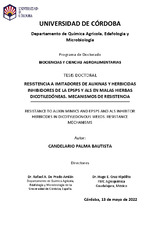Mostrar el registro sencillo del ítem
Resistencia a imitadores de auxinas y herbicidas inhibidores de la EPSPS y ALS en malas hierbas dicotiledóneas. Mecanismos de resistencia
| dc.contributor.advisor | Prado Amián, Rafael de | |
| dc.contributor.advisor | Cruz Hipólito, Hugo E. | |
| dc.contributor.author | Palma-Bautista, Candelario | |
| dc.date.accessioned | 2022-07-19T07:14:24Z | |
| dc.date.available | 2022-07-19T07:14:24Z | |
| dc.date.issued | 2022 | |
| dc.identifier.uri | http://hdl.handle.net/10396/23651 | |
| dc.description.abstract | Actualmente el control químico de las malas hierbas es la principal herramienta utilizada en el mundo dentro y fuera de los cultivos. Desde la introducción de los herbicidas se ha sometido a una gran cantidad de malas hierbas a una selección constate que ha dado como resultado la rápida evolución de la resistencia a los herbicidas. La ciencia de las malas hierbas ha establecido y sigue desarrollando protocolos para conocer y dilucidar los mecanismos que confieren resistencia a uno o varios herbicidas y especies de malas hierbas. La resistencia a herbicidas se divide en: resistencia dentro del sitio de acción (TSR) y resistencia fuera del sitio de acción (NTSR). La resistencia dentro del sitio de acción se atribuye generalmente a mutaciones en el gen que codifica la enzima objetivo del herbicida que provoca una disminución de su afinidad con el herbicida. La resistencia fuera del sitio de acción es el producto de la evolución más avanzada de las malas hierbas ya este impide que el herbicida llegue adecuadamente a su sitio de acción. Dentro de este grupo encontramos la absorción y translocación reducida, el secuestro vacuolar y el metabolismo de los herbicidas. Las malas hierbas pueden tener un solo mecanismo de resistencia o acumular varios mecanismos que se traduce en resistencia múltiple a varios herbicidas y que representan un gran desafío para la sostenibilidad de los herbicidas en la agricultura. En este trabajo de investigación se da a conocer el primer caso de resistencia a glifosato en Amaranthus palmeri que involucra exclusivamente mecanismos NTSR como la absorción y translocación diferenciada entre poblaciones. También se encontró resistencia a 2,4-D en seis especies dicotiledóneas donde el metabolismo mejorado y la translocación reducida son los responsables de la resistencia a este imitador de auxinas. Por otro lado, se estudió una población de Conyza bonariensis, donde por primera vez en el mundo se informa de la aparición de resistencia múltiple a herbicidas inhibidores de la aceto lactato sintasa (ALS) y la 5-enolpiruvylshikimato-3-fosfato sintasa (EPSPS), desviadores de electrones del fotosistema I (PSI), inhibidores del fotosistema II (PSII) y herbicidas imitadores de auxinas. Conocer y estudiar los mecanismos de resistencia a fondo es imprescindible para comprender la resistencia y construir soluciones que permitan desarrollar sistemas agrícolas sostenibles. El manejo integrado de malas hierbas (IWM) debe jugar un papel importante para disminuir esa presión de selección al que las malas hierban se sometido. | es_ES |
| dc.description.abstract | Chemical control of weeds is currently the main tool used in the world inside and outside of crops. Since the introduction of herbicides, large number of weeds have been subjected to constant selection pressureresulting to the rapid evolution of herbicide resistance. Weed science has established and continues to develop protocols to test and know the mechanisms that confer resistance for various herbicides and weed species. Herbicide resistance is classified into target site resistance (TSR) and non-target site resistance (NTSR). Target site resistance is generally attributed to mutations in the gene encoding the herbicide target enzyme that cause a decrease in its affinity for the herbicide. Non target site resistance is the product of the more advanced evolution and prevents the herbicide from reaching its site of action correctly. Within this group are reduced absorption and translocation, vacuolar sequestration and metabolism of herbicides. Weeds have a single resistance mechanism or accumulate several mechanisms that result in multiple resistance to several herbicides and that represent a major challenge to the sustainability of herbicides in agriculture. In this research work we report the first case of glyphosate resistance in Amaranthus palmeri involving exclusively NTSR mechanisms such as differential absorption and translocation between populations. Resistance to 2,4-D was also found in six dicot species in which enhanced metabolism and reduced translocation are responsible for resistance to this auxin mimic. On the other hand, a population of Conyza bonariensis was studied, where for the first time in the world multiple resistance to acetolactate synthase (ALS) and 5-enolpyruvylshikimate-3-phosphate synthase (EPSPS) inhibitor herbicides, photosystem I electron diverters, photosystem II inhibitors and auxin mimic herbicides. Knowledge and study of resistance mechanisms is essential to understand resistance and build solutions for the development of sustainable agricultural systems. Integrated weed management (IWM) has an important role to play in reducing the selection pressure to which weeds have been subjected. | es_ES |
| dc.format.mimetype | application/pdf | es_ES |
| dc.language.iso | spa | es_ES |
| dc.publisher | Universidad de Córdoba, UCOPress | es_ES |
| dc.rights | https://creativecommons.org/licenses/by-nc-nd/4.0/ | es_ES |
| dc.subject | Mecanismos TSR | es_ES |
| dc.subject | Mecanismos NTSR | es_ES |
| dc.subject | Absorción y translocación reducida | es_ES |
| dc.subject | Metabolismo mejorado | es_ES |
| dc.subject | Resistencia simple y múltiple | es_ES |
| dc.subject | TSR mechanisms | es_ES |
| dc.subject | NTSR mechanisms | es_ES |
| dc.subject | Reduced absorption and translocation | es_ES |
| dc.subject | Enhanced metabolism | es_ES |
| dc.subject | Single and multiple resistance | es_ES |
| dc.title | Resistencia a imitadores de auxinas y herbicidas inhibidores de la EPSPS y ALS en malas hierbas dicotiledóneas. Mecanismos de resistencia | es_ES |
| dc.title.alternative | Resistance to auxin mimics and EPSPS and ALS inhibitor herbicides in dicotyledonous weeds. Resistance mechanisms | es_ES |
| dc.type | info:eu-repo/semantics/doctoralThesis | es_ES |
| dc.rights.accessRights | info:eu-repo/semantics/openAccess | es_ES |

